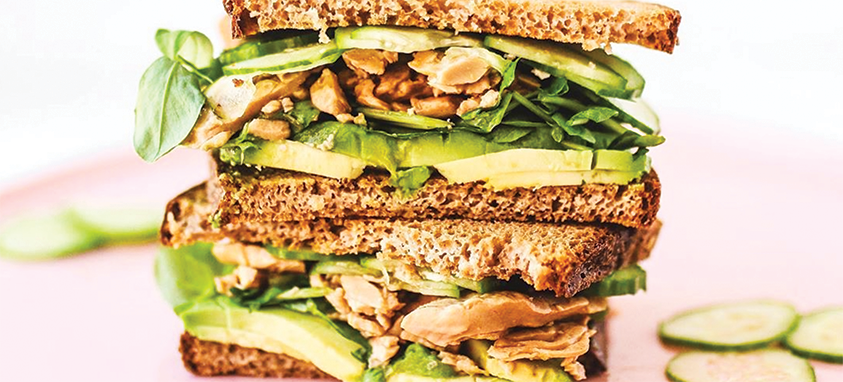Will plant-based fish be the next big thing in sustainable dining?
Who doesn’t love a good tuna-fish sandwich? Well, OK, vegetarians and vegans don’t. And some people don’t like the, um, distinct odor. We’ve even heard of instances of office shaming over that. (Ewww, what is that horrible fishy smell!)
But there’s a bigger problem with beloved tuna. Like 90 percent of the world’s sought-after ocean fish, its stock is severely depleted. Even worse for humans, every bite of tuna also comes with unwanted toxic mercury and PCBs (plastic).
So, perhaps it was only a matter of time—or, to put it another way, it’s just in time—that tuna joins hamburger beef in being imitated by plant-based alternatives so good that it’s hard to tell the difference. Except for one thing. There’s no tuna smell.
And faux tuna is just the start. Crab, scallops, shrimp and other popular sea flavors are either already on the market or soon will be available at a supermarket near you. Perhaps soon on the hotel catering menu, too.
“We set off on this project to create a fish-free tuna product because it’s one of the largest commodity foods in the world, and tuna fisheries, factory fisheries, are one of the most destructive in the world,” says Chad Sarno, cofounder of Good Catch, a company scheduled to ramp up to full-scale production this summer at its own 42,000-square-foot Ohio factory. “By capturing fish faster than they can reproduce, we are harming entire ecosystems that interact with those species, from the food they eat to the predators that eat them.”
Good Catch’s shelf-stable tuna product is already on the shelves at Whole Foods Market, where Sarno used to work as a corporate chef. It joins multiple skews (“crabcakes” made from potato starch and peas, as well as “prawns,” “scallops” and smoked “salmon”) offered by Sophie’s Kitchen. Other companies are diving in fast. Ocean Hugger Foods sells Ahimi, a plant-based alternative to raw tuna, to restaurants and supermarket sushi vendors. It’s made of fresh tomatoes, sesame oil and other simple ingredients. NPR calls it “a dead ringer for ahi tuna sashimi.”
Sarno spent a year perfecting a blend of GMO-free peas, chickpeas, lentils, soy, fava beans and navy beans to get the exact flakiness of seafood. His company website says sourcing organic ingredients is on the horizon. The tuna taste comes from an algae oil extract—which makes sense, because tuna eat fish down a food chain that starts with algae and other marine “veggies.” The oil is rich in omega-3s and “matches up nutritionally to what you’d find in fish,” according to Sarno’s partner, Eric Schnell. That includes 15 grams of protein per serving.
Awareness of the crisis state of the world’s fisheries is growing in tandem with our appetite for seafood. The United Nation’s Food and Agriculture Organization says fish consumption has been twice that of world population growth every year since 1961. Global demand for fish will increase by another 50 percent or more during the next 15 years, according to WorldFish, an organization dedicated to reducing hunger and poverty by improving fisheries and aquaculture. With spiraling demand will come spiraling prices.
Thus, for companies offering affordable, good tasting, nutrient-dense fish substitutes, the market seems bottomless. “There are 300 marine animals that are fished around the world for consumption and only 30 land animals,” Schnell says. “So, the opportunity to disrupt the marine category is 10 times bigger than chicken, beef and pork.”
Our oceans and lakes—and future generations of humankind—may thank them.
The Hook for Planners
With sustainability higher than ever on the checklist for planners and their attendees, deciding to put seafood on the menu is both increasingly problematic and an opportunity to raise consciousness about more eco-friendly choices.
The best catch: If fish is served, work with your hotel kitchen staff or caterer to source only seasonal and sustainable seafood. Among the most reliable guides is Seafood Watch from Monterey Bay Aquarium. The “avoid” category is for seafood that is overfished or farmed in ways that harm other marine life or the environment.
Wild vs. farmed: The staples of hotel and catering menus are the large predators, such as tuna, salmon and swordfish, when in fact the healthiest fish to eat are the smallest—such as sardines, herring and anchovies. Challenge your culinary team to create something wonderful that incorporates any of these. It’s usually assumed wild-caught is always better than farmed. In truth, both have issues. Fish in the wild are not only dwindling in supply: They can come with high levels of mercury, micro plastics and other contaminants. Fish farms can create pollution, impact biodiversity and potentially cause harm through overuse of antibiotics. But not all farms are created equal. A conscientious chef can track sources and research practices.
Vegan love: Food allergies and intolerances are on every planner’s radar these days, which may be reason enough to give plant-based fish a try. (Be aware, however, that some contain soy.) Your vegan attendees will love you, especially those who have chosen their path because of objection to the environmental costs of consuming meat on land and sea. That’s why supermarket sales of tasty meat and dairy substitutes are booming.





